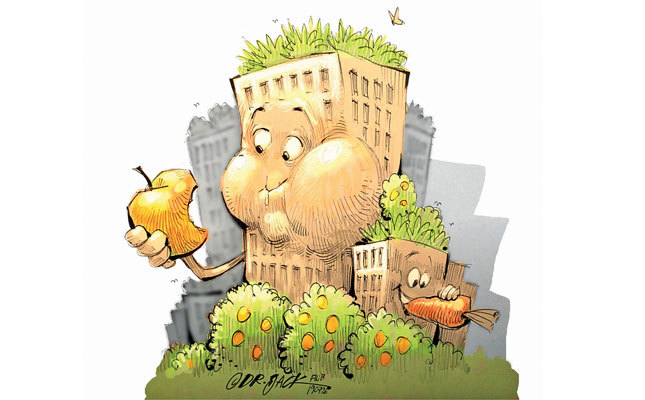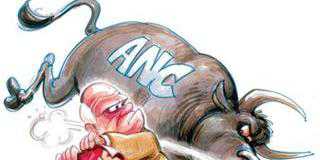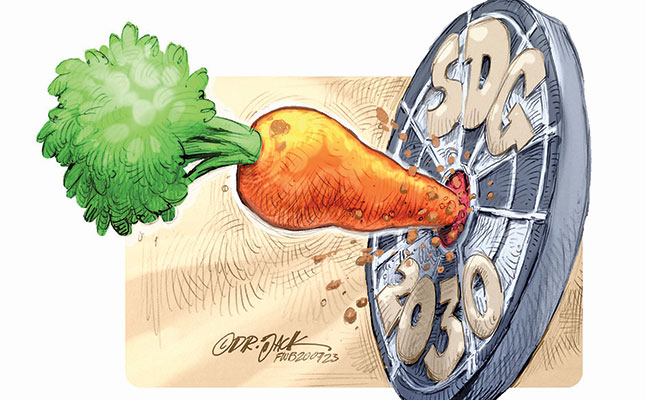
Worldwide, an average of three babies are born every second. This means that the global population grows by about 162 600 people per day, roughly equivalent to the population of George (157 000) or Midrand (173 000).
At the same time, spatial change is at a peak within the urban landscape, with 65% of South Africa’s population currently residing in cities.
READ How agriculture can ease the global urban water shortage
Our growing cities are also increasingly expensive living places characterised by urban sprawl and amplified travel distances, growing carbon footprints, increased energy consumption, and complicated distribution networks.
All this leads to higher food prices and greater food wastage, neither of which are beneficial to the urban poor. Recent data from Statistics South Africa suggests that 70% of urban households in South Africa live in conditions of food insecurity.
Bringing green spaces to urban areas
The world’s growing cities host more people, but less nature. Green spaces in cities have been susceptible to urban development pressures, evident in the depletion of green spaces and the associated downward spiral of living conditions.
In the search for “inclusive, safe, resilient and sustainable cities”, one of the UN’s Sustainable Development Goals, the interrelated role of nature as a catalyst to reach the objectives of sustainability, is emphasised.
READ Eastern Cape urban agri projects to be rejuvenated
There is consensus that we need to reclaim nature in cities in order to mitigate the challenges associated with these growing urban sprawls, while capitalising on the range of ecosystem services provided by nature.
Cities, which were once viewed as places where nature ends and urbanisation begins, are today considered as a central nexus in the relationship between people and nature.
It is within these contemporary cities that we need to find sustainable future solutions as a matter of urgency, because the challenge of sustaining life as we know it is becoming more complicated by the day.
Growing cities, increasing populations and escalating poverty levels mean that we cannot continue with a business-as-usual attitude.
One of the most important conservation issues of the 21st century is where and how food is produced in order to feed a growing and fast-urbanising population.
Traditional agricultural practices have been widely criticised for their negative environmental impact.
This includes deforestation, threats to wild species, the destruction of habitats and biodiversity, pollution of water, air and soil, high water consumption and water quality degradation, as well as greenhouse gas emission and climate change.
Growing cities place further pressures on agricultural practices. With urban sprawl comes prolonged distribution networks, complex food supply chains, more costly processing and packaging, and ultimately, more expensive produce, greater food waste and increased food insecurity.
Despite these negatives, agriculture remains one of the most important frontiers for conservation at the moment due to the industry’s deep connections with the global economy, human societies and biodiversity.
Our challenge lies in finding ways to best utilise space, energy and logistics in order to sustain an increasing urban population. In short, we need to rethink our cities, but we also need to rethink traditional agricultural practices.
Smart cities: easier accessibility and greater choice
The concept of smart cities is increasingly recognised as part of the discourse on sustainable cities.
To most people, a ‘smart city’ is one that is technology-driven and futuristic, where real-time intelligence informs decision-making and anticipates and mitigates a range of societal problems. From a spatial planning perspective, a smart city implies accessibility and choice.
Accessibility refers to better structured networks and connections between communities and their host cities, while choice refers to a range of housing and transportation options. From an agricultural perspective, accessibility and choice pertain to options to ensure food security within the contemporary city.
Agricultural technologies and smart data and analytics are set to increase food production within cities. They will also help meet the ever-growing global demand and logistical distribution of food without further disturbing the urban environment. This smart city solution is encapsulated in the notion of urban agriculture.
Grow food in places where it was previously impossible
Urban agriculture offers innovative, sustainable solutions to the improvement of food security in cities, and simultaneously assists with mitigating the environmental challenges faced by cities.
Urban agriculture can be as simple as small, outdoor community, rooftop and backyard gardens, or as complex as indoor vertical farms with nutrient-enriched water and UV lighting to mimic the effects of the sun.
READ Women in agriculture are key to boosting food security
New technologies enable food to be grown in places where it was previously difficult or impossible, making urban agriculture a viable option for cities where space is limited.
Although not all crops can be grown indoors, urban agriculture has the potential to become a dynamic economic sector that can quickly adapt to changing urban conditions and demands, diversifying the functions of the city.
Urban agriculture makes it possible to produce fresh, nutritious food with low carbon and water footprints, while conserving land, reducing emissions and waste, and providing healthy, affordable, accessible food to a city’s poorest residents.
It is, therefore, not surprising that a growing number of cities worldwide have already designed policies and programmes to include urban agriculture as part of city planning.
Perhaps South Africa, too, should consider the integration of urban agriculture in mainstream spatial planning, and guide cities towards the creation of demarcated zones for urban agricultural production.
When urban agriculture is formalised as a land use, it has the potential to change the entire urban and agricultural landscape, increase access to healthy food options in urban areas, and mitigate the environmental impact of feeding the world.
Although urban agriculture might not be the only solution to solving food security across the world, it is certainly part of the solution to feed the 70% of urban poor households in South Africa, adding to the development of sustainable, socially inclusive, food-secure and environmentally healthy cities.
The views expressed in our weekly opinion piece do not necessarily reflect those of Farmer’s Weekly.
Email Prof Juaneé Cilliers at [email protected].













